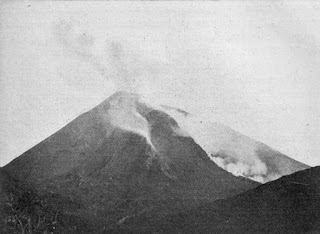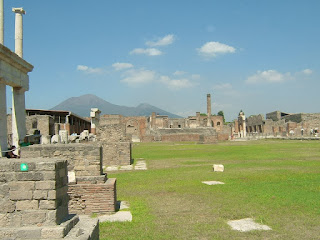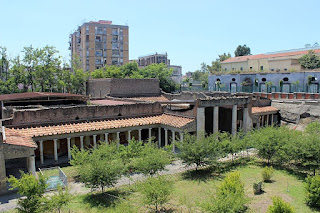Deadliest incident of the 20th century
 |
| A dramatic colour postcard image of the 1906 eruption seen from the Bay of Naples |
The volcano, most famous for the 79AD eruption that buried the city of Pompeii and may have claimed between 13,000 to 16,000 victims, had been spewing lava for almost 11 months, treating the residents of nearby Naples to regular fireworks displays.
On 5 April, 1906, an indication that a major eruption was imminent came in a failure in the water supply drawn from wells on the mountain sides, with such water as was still flowing having a strong taste of sulphur. The expulsions of lava became more explosive and an ash cloud began to form in the sky above the crater.
In the preceding days, there had been an earthquake on the island of Ustica some 130km (81 miles) away, which was thought to be connected to the Vesuvius eruption.
On the evening of 7 April came the biggest explosion, as well as three earthquakes felt in the city of Naples, which were said to cause much panic, but no particular damage.
_(14770663784).jpg) |
| A photograph taken from Naples shows the huge cloud of ash that plunged the city into darkness |
For a while, there were fears that the ruins of Pompeii and the coastal city of Torre Annunziata - built on the ruins of Oplonti, another Roman city destroyed in 79AD - would suffer the same fate. Mercifully, the lava stopped short.
The 1906 eruption, which came to be known as the Grand Eruption, ejected the most lava of any eruption of which there are reliable records but it was the massive volume of ash rising from the crater that caused most of the deaths, estimated at between 100 and 200, with some reports suggesting as many as 216 casualties. It would remain the deadliest eruption of the 20th century.
The mountain itself was covered in a deep layer of grit and ashes, understandably. But for miles around, as far away as the plain of Sorrento and the island of Capri, buildings, trees and fields were coated in what looked like a fall of dirty snow. In the city of Naples itself, scientists calculated that some 315,000 tons of burning dust fell to earth, leaving streets and gardens unrecognisable.
The biggest single loss of life was in the village of San Giuseppe, to the east of the crater, where people crowded into a little church, imagining it would be a place of safety, only for the roof to fall in from the weight of ash. Many neighbouring houses suffered a similar fate. In neighbouring Ottojano - Ottoviano today - many poorly constructed houses were destroyed.
 |
| Vesuvius - or Monte Somma - as it appeared before the 1906 eruption blew off its cone |
Residents who escaped serious injury had to contend with the threat to their eyes of falling cinder, prompting a busy trade in protective glasses and umbrellas.
The streets of the city were effectively in darkness for several days until a shift in the wind direction allowed the sunlight to shine through again. Residents offered thanks to San Gennaro, the patron saint of the city, for deliverance.
All the time there was a sense of chaos as 150,000 residents fled villages in the immediate vicinity of the mountain and descended on Naples, while the railway station was besieged by overseas visitors to the city, mainly German, English and American, trying to board trains out of the area.
The rescue efforts were shared between the army and the Carabinieri, who won much praise for their tireless work in digging among the rubble for survivors and clearing away a landslide that blocked the Circumvesuviana railway line. The royal commander of the army, the Duke of Aosta, visited in person with his wife, the popular Princess Hélène, to rally troops and raise the spirits of residents.
The people of Naples gave thanks also to Professor Raffaele Vittorio Matteucci, director of the Vesuvius Laboratory, who stayed at his post for as long as possible, despite the danger of being burnt or asphyxiated, to pass on vital warnings to citizens of what was to come.
The consequences of the catastrophe were not limited to damage to buildings and loss of life. The cost of repairing the damage and looking after the thousands made homeless inevitably fell to the government in Rome, who had to abandon their plans to host the Olympic Games in 1908 on the grounds that they could no longer justify the expense.
The Games instead went to London, with Rome obliged to wait another 52 years, until 1960, to host Italy’s only summer Olympics to date.
After the eruption, Vesuvius itself - also known as Monte Somma - had a different appearance, losing its cone and around 170m (558ft) in height.
 |
| The ruins of Pompeii - with Vesuvius in the background - attract thousands of visitors |
The excavated ruins of Pompeii - gli scavi - are among the most popular tourist attractions in Italy and many important artefacts have been dug up. When Vesuvius started rumbling in August 79AD and a sinister cloud began to form above it, some people left the area immediately. It is believed those who stayed died from the effects of the heat and their bodies were buried under the stones and ash for hundreds of years. Engineers rediscovered them while digging an aqueduct. The first organised excavations began in 1748 and the site soon became an attraction for wealthy Europeans on the Grand Tour. Trains from the Circumvesuviana railway station in Naples run to Sorrento every half an hour, stopping at Pompei Scavi station. From the station it is a short walk to the main entrance to the archaeological site in Piazza Porta Marina. The ruins are open daily from 8.30 to 19.30 during the summer and from 8.30 to 17.00 between November and April.
Hotels in Pompei by Booking.com
 |
| The ruins of the Villa Oplontis, part of the city destroyed by the 1906 Vesuvius eruption |
Torre Annunziata, which escaped the worst of the 1906 eruption, was destroyed in the eruption of 79AD, when it was known as Oplonti. The present-day city was rebuilt over the ruins. Its name derives from a watch tower - torre - built to warn people of imminent Saracen raids and a chapel consecrated to the Annunziata (Virgin Mary). It became a centre for pasta production in the early 19th century. The Villa Poppaea, also known as Villa Oplontis, believed to be owned by Nero, was discovered about ten metres below ground level just outside the town and is now a UNESCO World Heritage Site.
Torre Annunziata hotels by Booking.com
Also on this day:
1763: The birth of musician Domenico Dragonetti
1794: The birth of operatic tenor Giovanni Battista Rubini
1973: The birth of footballer Marco Delvecchio
No comments:
Post a Comment